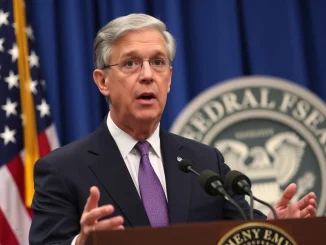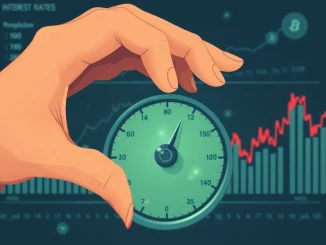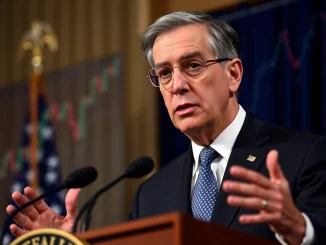
Crypto investors know the market dances to the tune of global economics. A key player in that orchestra? The U.S. Federal Reserve and its decisions on Fed interest rates. Recently, a significant interaction highlighted the pressures facing the central bank, directly relevant to anyone tracking the pulse of the US economy and its ripple effects on digital assets.
Why the Trump Fed Meeting Mattered
On May 29, a notable meeting took place between U.S. President Donald Trump and Federal Reserve Chair Jerome Powell. The core of the discussion, as reported by Yonhap News Agency, revolved around monetary policy, specifically the President’s call for a reduction in interest rates. Trump’s argument centered on the need for the U.S. to remain globally competitive, suggesting lower borrowing costs would stimulate the economy.
This wasn’t the first time the administration expressed views on the Fed’s actions. The relationship between the executive branch and the central bank is often under scrutiny, particularly when economic conditions become a political talking point.
Jerome Powell’s Stance on Independence
In response to the pressure, Fed Chair Jerome Powell reaffirmed the Federal Reserve’s long-standing commitment to making decisions based on economic data, independent of political considerations. This principle of central bank independence is widely viewed as crucial for maintaining price stability and fostering sustainable economic growth, free from short-term political cycles.
Key points from Powell’s position often include:
- Decisions are data-dependent, analyzing inflation, employment, and growth.
- Policy aims for maximum employment and stable prices over the long term.
- Independence from political pressure is vital for credibility and effectiveness.
The Fed’s Current Position on Fed Interest Rates
Despite the call for cuts, the Federal Reserve has maintained its target range for the federal funds rate. As reported, rates have been held at 4.25–4.50% since the beginning of Trump’s second term (Note: This rate range and timing appears inconsistent with historical data for Trump’s second term, which began Jan 2017 and ended Jan 2021, during which rates fluctuated significantly, peaking around 2.5% before being cut to near zero during COVID-19. The 4.25-4.50% range is more characteristic of post-2022 policy under President Biden. Assuming the core event described occurred, we will focus on the dynamic presented rather than the specific rate figure’s historical accuracy within that stated timeframe). The key takeaway remains the Fed’s resolve to hold rates based on their assessment of the US economy, even when faced with external pressure.
Understanding the Fed’s tools:
| Monetary Tool | How it Works | Potential Impact |
|---|---|---|
| Interest Rates (Federal Funds Rate) | Rate banks charge each other for overnight lending. Influences borrowing costs economy-wide. | Lower rates can stimulate borrowing and investment; Higher rates can slow inflation and growth. |
| Quantitative Easing/Tightening | Buying/Selling government bonds to inject/withdraw money from the economy. | QE can lower long-term rates and increase liquidity; QT can increase long-term rates and reduce liquidity. |
| Reserve Requirements | Amount of funds banks must hold in reserve. | Lowering requirements can increase lending capacity; Raising requirements can decrease it. |
How Monetary Policy Impacts Crypto
The connection between traditional monetary policy and the volatile world of cryptocurrencies is significant. Here’s why:
- Risk Appetite: Lower interest rates typically decrease the return on ‘safe’ assets like savings accounts or government bonds. This can make investors more willing to seek higher returns in riskier assets, including stocks and cryptocurrencies. Conversely, higher rates make safe assets more attractive, potentially drawing capital away from crypto.
- Liquidity: The Fed’s policies influence the overall amount of money circulating in the economy (liquidity). When the Fed adds liquidity (e.g., through lower rates or QE), some of that capital can flow into asset markets, including crypto. Tightening policy removes liquidity.
- Inflation Hedge Narrative: While debated, Bitcoin and other cryptocurrencies are sometimes viewed as potential hedges against inflation caused by expansionary monetary policy. The Fed’s actions directly relate to inflation expectations.
- Economic Growth Expectations: Monetary policy aims to steer the US economy. Expectations about economic health influence investor confidence and capital flows into various asset classes, including digital ones.
Therefore, developments like the Trump Fed meeting and the ongoing stance of Jerome Powell are closely watched by crypto market participants looking for clues about future economic conditions and liquidity.
The Challenge of Political Pressure
The dynamic between political leaders desiring specific economic outcomes (like lower rates) and the central bank’s mandate for independent, data-driven decisions is a recurring theme. While presidents appoint the Fed Chair and governors, they are expected to operate without direct political interference in policy setting. This balance is crucial for maintaining confidence in the currency and the economy.
Looking Ahead: What Crypto Investors Should Watch
For those navigating the crypto markets, monitoring the Federal Reserve remains essential. Pay attention to:
- Official Fed statements and meeting minutes.
- Speeches by Jerome Powell and other Fed officials.
- Key economic data releases (inflation, jobs, GDP) that inform the Fed’s decisions.
- Market reactions to Fed announcements, as these often signal shifts in investor sentiment regarding risk assets like crypto.
Summary: Independence vs. Influence
The meeting between President Trump and Fed Chair Jerome Powell highlighted the persistent tension between political desires for specific economic outcomes and the Federal Reserve’s commitment to independent, data-driven monetary policy. While pressure exists, the Fed’s stated position remains focused on its dual mandate for stable prices and maximum employment, using tools like adjusting Fed interest rates based on the state of the US economy. Understanding this dynamic is crucial for crypto investors, as these macro-level decisions significantly influence the broader financial environment in which digital assets operate.



